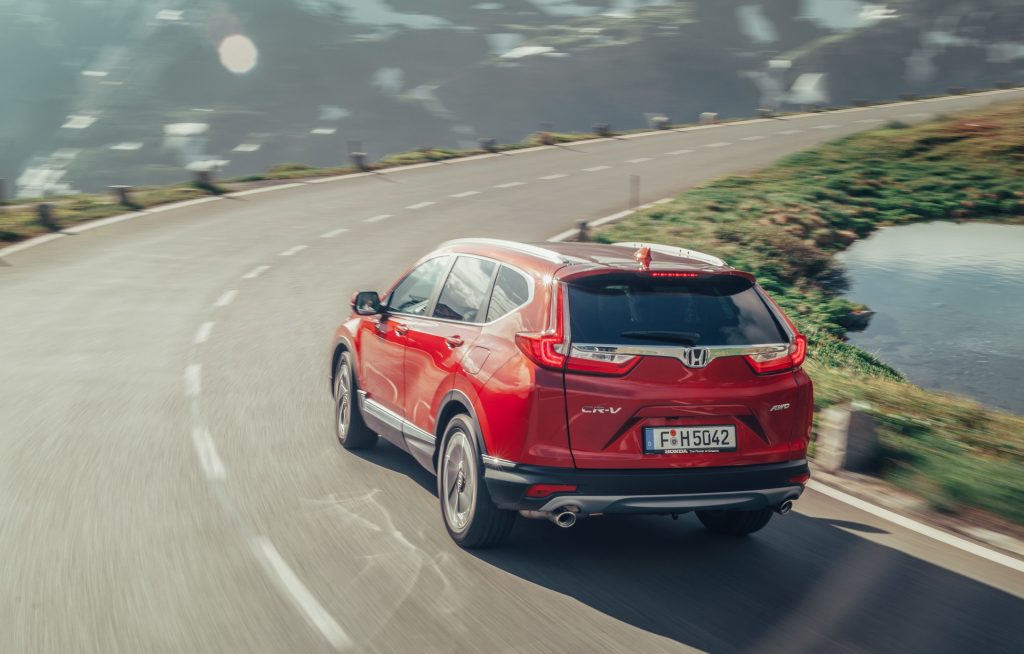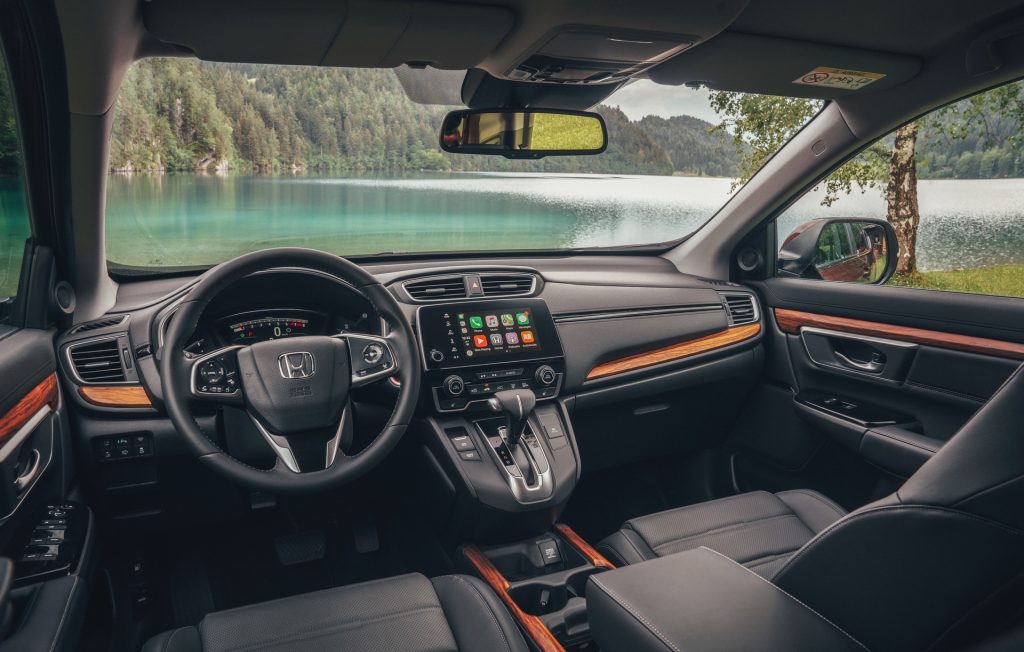Honda is currently launching the Euro-spec CR-V in Europe, which will be available with a single engine option, the 1.5-liter VTEC Turbo petrol unit known from the Civic and of course the US-spec CR-V.
Customers in Europe will be offered the choice of either a manual front- or all-wheel drive version, as well as a CVT automatic that’s only available with the latter.
When fitted with the six-speed manual, the 2018 Honda CR-V offers 170hp (173PS) and 162lb-ft (220Nm) of torque. Go for the CVT and the figures go up by a little, at 190hp (193PS) and 179lb-ft (243Nm).
Despite the increased horsepower, it’s the manual Honda CR-V that offers the better acceleration; Honda claims a 0-62mph (100km/h) in 9.2 seconds and a top speed of 130mph (210km/h) for the FWD model, with the automatic CR-V AWD offering 10 seconds and 124mph (200km/h) respectively.
Fuel economy goes as low as 44.8mpg UK (6.3lt/100km) combined, while CO2 emissions are rated at 143g/km for the manual front-drive CR-V.
Honda has already confirmed that they won’t offer a diesel derivative of the CR-V in the region. Instead, they plan to launch a new hybrid version early next year, featuring a 2.0-liter i-VTEC paired to an electric motor and a separate electric generator motor.
The fourth-generation Honda CR-V is the first one to be offered with seven seats as an option. Honda claims that the new CR-V also offers class-leading interior space thanks to its longer wheelbase.
In addition, the Japanese company says that the body of their new SUV offers the best rigidity and stiffness in the segment while the Honda Sensing suite of active safety technologies is fitted as standard. This apparently results into a solid five-star rating at the Euro NCAP safety assessment.
Ground clearance has been increased by 35mm over its predecessor, with 191mm for the front-drive models and 201mm for all-wheel drive models. The AWD system can send up to 60percent of the torque to the rear wheels if required.
The all-new chassis features a MacPherson strut suspension at the front and a multi-link setup at the rear, with both axles getting hydraulic suspension bushings for greater ride isolation as standard across the range.



![Honda Launches 2018 CR-V In Europe With 1.5-Liter Turbo [78 Images]](https://www.carscoops.com/wp-content/uploads/2024/04/Hyundai-Ioniq-5-N-1024x576.jpg)
![Honda Launches 2018 CR-V In Europe With 1.5-Liter Turbo [78 Images]](https://www.carscoops.com/wp-content/uploads/2024/04/2025-Toyota-4Runner-80-Stephen-Rivers-for-Carscoops-copy-1024x576.jpg)
![Honda Launches 2018 CR-V In Europe With 1.5-Liter Turbo [78 Images]](https://www.carscoops.com/wp-content/uploads/2024/04/2025_Toyota_4Runner_TRDPro_Mudbath_049-copy-1024x576.jpg)
![Honda Launches 2018 CR-V In Europe With 1.5-Liter Turbo [78 Images]](https://www.carscoops.com/wp-content/uploads/2024/04/ythgvf-1024x576.jpg)
![Honda Launches 2018 CR-V In Europe With 1.5-Liter Turbo [78 Images]](https://www.carscoops.com/wp-content/uploads/2023/06/ForCarscoops-1024x683.jpg)
![Honda CR-V (5 & 7 Seats) Honda Launches 2018 CR-V In Europe With 1.5-Liter Turbo [78 Images]](https://www.carscoops.com/wp-content/uploads/2018/07/d12ce0f9-2018-honda-cr-v-00-1024x555.jpg)


![2018-Honda-CR-V-79 Honda Launches 2018 CR-V In Europe With 1.5-Liter Turbo [78 Images]](https://www.carscoops.com/wp-content/uploads/2018/07/8b8aef63-2018-honda-cr-v-79.jpg)
![2018-Honda-CR-V-78 Honda Launches 2018 CR-V In Europe With 1.5-Liter Turbo [78 Images]](https://www.carscoops.com/wp-content/uploads/2018/07/0336592c-2018-honda-cr-v-78.jpg)
![2018-Honda-CR-V-77 Honda Launches 2018 CR-V In Europe With 1.5-Liter Turbo [78 Images]](https://www.carscoops.com/wp-content/uploads/2018/07/505fb372-2018-honda-cr-v-77.jpg)
![2018-Honda-CR-V-76 Honda Launches 2018 CR-V In Europe With 1.5-Liter Turbo [78 Images]](https://www.carscoops.com/wp-content/uploads/2018/07/8441b2dd-2018-honda-cr-v-76.jpg)
![2018-Honda-CR-V-75 Honda Launches 2018 CR-V In Europe With 1.5-Liter Turbo [78 Images]](https://www.carscoops.com/wp-content/uploads/2018/07/94a30a8d-2018-honda-cr-v-75.jpg)
![2018-Honda-CR-V-74 Honda Launches 2018 CR-V In Europe With 1.5-Liter Turbo [78 Images]](https://www.carscoops.com/wp-content/uploads/2018/07/94be75a5-2018-honda-cr-v-74.jpg)
![2018-Honda-CR-V-72 Honda Launches 2018 CR-V In Europe With 1.5-Liter Turbo [78 Images]](https://www.carscoops.com/wp-content/uploads/2018/07/2a075491-2018-honda-cr-v-72.jpg)
![2018-Honda-CR-V-71 Honda Launches 2018 CR-V In Europe With 1.5-Liter Turbo [78 Images]](https://www.carscoops.com/wp-content/uploads/2018/07/308591a9-2018-honda-cr-v-71.jpg)
![2018-Honda-CR-V-70 Honda Launches 2018 CR-V In Europe With 1.5-Liter Turbo [78 Images]](https://www.carscoops.com/wp-content/uploads/2018/07/fb3e79a5-2018-honda-cr-v-70.jpg)
![2018-Honda-CR-V-69 Honda Launches 2018 CR-V In Europe With 1.5-Liter Turbo [78 Images]](https://www.carscoops.com/wp-content/uploads/2018/07/126ad19c-2018-honda-cr-v-69.jpg)
![2018-Honda-CR-V-68 Honda Launches 2018 CR-V In Europe With 1.5-Liter Turbo [78 Images]](https://www.carscoops.com/wp-content/uploads/2018/07/48562796-2018-honda-cr-v-68.jpg)
![2018-Honda-CR-V-67 Honda Launches 2018 CR-V In Europe With 1.5-Liter Turbo [78 Images]](https://www.carscoops.com/wp-content/uploads/2018/07/855a4dc4-2018-honda-cr-v-67.jpg)
![2018-Honda-CR-V-66 Honda Launches 2018 CR-V In Europe With 1.5-Liter Turbo [78 Images]](https://www.carscoops.com/wp-content/uploads/2018/07/4043ca59-2018-honda-cr-v-66.jpg)
![2018-Honda-CR-V-65 Honda Launches 2018 CR-V In Europe With 1.5-Liter Turbo [78 Images]](https://www.carscoops.com/wp-content/uploads/2018/07/97f55e30-2018-honda-cr-v-65.jpg)
![2018-Honda-CR-V-64 Honda Launches 2018 CR-V In Europe With 1.5-Liter Turbo [78 Images]](https://www.carscoops.com/wp-content/uploads/2018/07/80f5cb13-2018-honda-cr-v-64.jpg)
![2018-Honda-CR-V-63 Honda Launches 2018 CR-V In Europe With 1.5-Liter Turbo [78 Images]](https://www.carscoops.com/wp-content/uploads/2018/07/89dbf141-2018-honda-cr-v-63.jpg)
![2018-Honda-CR-V-62 Honda Launches 2018 CR-V In Europe With 1.5-Liter Turbo [78 Images]](https://www.carscoops.com/wp-content/uploads/2018/07/320cf21a-2018-honda-cr-v-62.jpg)
![2018-Honda-CR-V-61 Honda Launches 2018 CR-V In Europe With 1.5-Liter Turbo [78 Images]](https://www.carscoops.com/wp-content/uploads/2018/07/227343b8-2018-honda-cr-v-61.jpg)
![2018-Honda-CR-V-60 Honda Launches 2018 CR-V In Europe With 1.5-Liter Turbo [78 Images]](https://www.carscoops.com/wp-content/uploads/2018/07/ea5bd3fc-2018-honda-cr-v-60.jpg)
![2018-Honda-CR-V-59 Honda Launches 2018 CR-V In Europe With 1.5-Liter Turbo [78 Images]](https://www.carscoops.com/wp-content/uploads/2018/07/d7eecf4f-2018-honda-cr-v-59.jpg)
![2018-Honda-CR-V-58 Honda Launches 2018 CR-V In Europe With 1.5-Liter Turbo [78 Images]](https://www.carscoops.com/wp-content/uploads/2018/07/aff67d99-2018-honda-cr-v-58.jpg)
![2018-Honda-CR-V-57 Honda Launches 2018 CR-V In Europe With 1.5-Liter Turbo [78 Images]](https://www.carscoops.com/wp-content/uploads/2018/07/2eb3c8eb-2018-honda-cr-v-57.jpg)
![2018-Honda-CR-V-56 Honda Launches 2018 CR-V In Europe With 1.5-Liter Turbo [78 Images]](https://www.carscoops.com/wp-content/uploads/2018/07/062e892f-2018-honda-cr-v-56.jpg)
![2018-Honda-CR-V-55 Honda Launches 2018 CR-V In Europe With 1.5-Liter Turbo [78 Images]](https://www.carscoops.com/wp-content/uploads/2018/07/7aa12333-2018-honda-cr-v-55.jpg)
![2018-Honda-CR-V-54 Honda Launches 2018 CR-V In Europe With 1.5-Liter Turbo [78 Images]](https://www.carscoops.com/wp-content/uploads/2018/07/3757d66e-2018-honda-cr-v-54.jpg)
![2018-Honda-CR-V-53 Honda Launches 2018 CR-V In Europe With 1.5-Liter Turbo [78 Images]](https://www.carscoops.com/wp-content/uploads/2018/07/32485ef7-2018-honda-cr-v-53.jpg)
![2018-Honda-CR-V-52 Honda Launches 2018 CR-V In Europe With 1.5-Liter Turbo [78 Images]](https://www.carscoops.com/wp-content/uploads/2018/07/4dd5bdfe-2018-honda-cr-v-52.jpg)
![2018-Honda-CR-V-51 Honda Launches 2018 CR-V In Europe With 1.5-Liter Turbo [78 Images]](https://www.carscoops.com/wp-content/uploads/2018/07/2a6a5678-2018-honda-cr-v-51.jpg)
![2018-Honda-CR-V-50 Honda Launches 2018 CR-V In Europe With 1.5-Liter Turbo [78 Images]](https://www.carscoops.com/wp-content/uploads/2018/07/9c366c98-2018-honda-cr-v-50.jpg)
![2018-Honda-CR-V-49 Honda Launches 2018 CR-V In Europe With 1.5-Liter Turbo [78 Images]](https://www.carscoops.com/wp-content/uploads/2018/07/3efe8aee-2018-honda-cr-v-49.jpg)
![2018-Honda-CR-V-48 Honda Launches 2018 CR-V In Europe With 1.5-Liter Turbo [78 Images]](https://www.carscoops.com/wp-content/uploads/2018/07/bbc69c6f-2018-honda-cr-v-48.jpg)
![2018-Honda-CR-V-47 Honda Launches 2018 CR-V In Europe With 1.5-Liter Turbo [78 Images]](https://www.carscoops.com/wp-content/uploads/2018/07/14735626-2018-honda-cr-v-47.jpg)
![2018-Honda-CR-V-46 Honda Launches 2018 CR-V In Europe With 1.5-Liter Turbo [78 Images]](https://www.carscoops.com/wp-content/uploads/2018/07/dcb7f738-2018-honda-cr-v-46.jpg)
![2018-Honda-CR-V-45 Honda Launches 2018 CR-V In Europe With 1.5-Liter Turbo [78 Images]](https://www.carscoops.com/wp-content/uploads/2018/07/b769fbc7-2018-honda-cr-v-45.jpg)
![2018-Honda-CR-V-44 Honda Launches 2018 CR-V In Europe With 1.5-Liter Turbo [78 Images]](https://www.carscoops.com/wp-content/uploads/2018/07/21ab7048-2018-honda-cr-v-44.jpg)
![2018-Honda-CR-V-43 Honda Launches 2018 CR-V In Europe With 1.5-Liter Turbo [78 Images]](https://www.carscoops.com/wp-content/uploads/2018/07/6a6b9fa8-2018-honda-cr-v-43.jpg)
![2018-Honda-CR-V-42 Honda Launches 2018 CR-V In Europe With 1.5-Liter Turbo [78 Images]](https://www.carscoops.com/wp-content/uploads/2018/07/d2b8be2d-2018-honda-cr-v-42.jpg)
![2018-Honda-CR-V-41 Honda Launches 2018 CR-V In Europe With 1.5-Liter Turbo [78 Images]](https://www.carscoops.com/wp-content/uploads/2018/07/b71f2248-2018-honda-cr-v-41.jpg)
![2018-Honda-CR-V-40 Honda Launches 2018 CR-V In Europe With 1.5-Liter Turbo [78 Images]](https://www.carscoops.com/wp-content/uploads/2018/07/8e28ed1b-2018-honda-cr-v-40.jpg)
![2018-Honda-CR-V-39 Honda Launches 2018 CR-V In Europe With 1.5-Liter Turbo [78 Images]](https://www.carscoops.com/wp-content/uploads/2018/07/958c1d8c-2018-honda-cr-v-39.jpg)
![2018-Honda-CR-V-38 Honda Launches 2018 CR-V In Europe With 1.5-Liter Turbo [78 Images]](https://www.carscoops.com/wp-content/uploads/2018/07/e10108ba-2018-honda-cr-v-38.jpg)
![2018-Honda-CR-V-37 Honda Launches 2018 CR-V In Europe With 1.5-Liter Turbo [78 Images]](https://www.carscoops.com/wp-content/uploads/2018/07/9525dd64-2018-honda-cr-v-37.jpg)
![2018-Honda-CR-V-36 Honda Launches 2018 CR-V In Europe With 1.5-Liter Turbo [78 Images]](https://www.carscoops.com/wp-content/uploads/2018/07/dca1566f-2018-honda-cr-v-36.jpg)
![2018-Honda-CR-V-35 Honda Launches 2018 CR-V In Europe With 1.5-Liter Turbo [78 Images]](https://www.carscoops.com/wp-content/uploads/2018/07/cded0c9a-2018-honda-cr-v-35.jpg)
![2018-Honda-CR-V-34 Honda Launches 2018 CR-V In Europe With 1.5-Liter Turbo [78 Images]](https://www.carscoops.com/wp-content/uploads/2018/07/3b82ae6e-2018-honda-cr-v-34.jpg)
![2018-Honda-CR-V-33 Honda Launches 2018 CR-V In Europe With 1.5-Liter Turbo [78 Images]](https://www.carscoops.com/wp-content/uploads/2018/07/ad193fb9-2018-honda-cr-v-33.jpg)
![2018-Honda-CR-V-32 Honda Launches 2018 CR-V In Europe With 1.5-Liter Turbo [78 Images]](https://www.carscoops.com/wp-content/uploads/2018/07/065e55fc-2018-honda-cr-v-32.jpg)
![2018-Honda-CR-V-31 Honda Launches 2018 CR-V In Europe With 1.5-Liter Turbo [78 Images]](https://www.carscoops.com/wp-content/uploads/2018/07/b6fb9b7e-2018-honda-cr-v-31.jpg)
![2018-Honda-CR-V-30 Honda Launches 2018 CR-V In Europe With 1.5-Liter Turbo [78 Images]](https://www.carscoops.com/wp-content/uploads/2018/07/d5239d8e-2018-honda-cr-v-30.jpg)
![2018-Honda-CR-V-29 Honda Launches 2018 CR-V In Europe With 1.5-Liter Turbo [78 Images]](https://www.carscoops.com/wp-content/uploads/2018/07/0e9b25b0-2018-honda-cr-v-29.jpg)
![2018-Honda-CR-V-28 Honda Launches 2018 CR-V In Europe With 1.5-Liter Turbo [78 Images]](https://www.carscoops.com/wp-content/uploads/2018/07/4114c755-2018-honda-cr-v-28.jpg)
![2018-Honda-CR-V-27 Honda Launches 2018 CR-V In Europe With 1.5-Liter Turbo [78 Images]](https://www.carscoops.com/wp-content/uploads/2018/07/b32eb024-2018-honda-cr-v-27.jpg)
![2018-Honda-CR-V-26 Honda Launches 2018 CR-V In Europe With 1.5-Liter Turbo [78 Images]](https://www.carscoops.com/wp-content/uploads/2018/07/9d335579-2018-honda-cr-v-26.jpg)
![2018-Honda-CR-V-25 Honda Launches 2018 CR-V In Europe With 1.5-Liter Turbo [78 Images]](https://www.carscoops.com/wp-content/uploads/2018/07/ec219215-2018-honda-cr-v-25.jpg)
![2018-Honda-CR-V-24 Honda Launches 2018 CR-V In Europe With 1.5-Liter Turbo [78 Images]](https://www.carscoops.com/wp-content/uploads/2018/07/6966de14-2018-honda-cr-v-24.jpg)
![2018-Honda-CR-V-23 Honda Launches 2018 CR-V In Europe With 1.5-Liter Turbo [78 Images]](https://www.carscoops.com/wp-content/uploads/2018/07/07ef27ff-2018-honda-cr-v-23.jpg)
![2018-Honda-CR-V-22 Honda Launches 2018 CR-V In Europe With 1.5-Liter Turbo [78 Images]](https://www.carscoops.com/wp-content/uploads/2018/07/2479fbff-2018-honda-cr-v-22.jpg)
![2018-Honda-CR-V-21 Honda Launches 2018 CR-V In Europe With 1.5-Liter Turbo [78 Images]](https://www.carscoops.com/wp-content/uploads/2018/07/c7812c2a-2018-honda-cr-v-21.jpg)
![2018-Honda-CR-V-20 Honda Launches 2018 CR-V In Europe With 1.5-Liter Turbo [78 Images]](https://www.carscoops.com/wp-content/uploads/2018/07/a003e5e6-2018-honda-cr-v-20.jpg)
![2018-Honda-CR-V-19 Honda Launches 2018 CR-V In Europe With 1.5-Liter Turbo [78 Images]](https://www.carscoops.com/wp-content/uploads/2018/07/104a575a-2018-honda-cr-v-19.jpg)
![2018-Honda-CR-V-18 Honda Launches 2018 CR-V In Europe With 1.5-Liter Turbo [78 Images]](https://www.carscoops.com/wp-content/uploads/2018/07/56ab60d3-2018-honda-cr-v-18.jpg)
![2018-Honda-CR-V-17 Honda Launches 2018 CR-V In Europe With 1.5-Liter Turbo [78 Images]](https://www.carscoops.com/wp-content/uploads/2018/07/1bde9185-2018-honda-cr-v-17.jpg)
![2018-Honda-CR-V-16 Honda Launches 2018 CR-V In Europe With 1.5-Liter Turbo [78 Images]](https://www.carscoops.com/wp-content/uploads/2018/07/1d44f1e4-2018-honda-cr-v-16.jpg)
![2018-Honda-CR-V-15 Honda Launches 2018 CR-V In Europe With 1.5-Liter Turbo [78 Images]](https://www.carscoops.com/wp-content/uploads/2018/07/aa5733fa-2018-honda-cr-v-15.jpg)
![2018-Honda-CR-V-14 Honda Launches 2018 CR-V In Europe With 1.5-Liter Turbo [78 Images]](https://www.carscoops.com/wp-content/uploads/2018/07/a080d15b-2018-honda-cr-v-14.jpg)
![2018-Honda-CR-V-13 Honda Launches 2018 CR-V In Europe With 1.5-Liter Turbo [78 Images]](https://www.carscoops.com/wp-content/uploads/2018/07/25cbcc8e-2018-honda-cr-v-13.jpg)
![2018-Honda-CR-V-12 Honda Launches 2018 CR-V In Europe With 1.5-Liter Turbo [78 Images]](https://www.carscoops.com/wp-content/uploads/2018/07/c7c0bb99-2018-honda-cr-v-12.jpg)
![2018-Honda-CR-V-11 Honda Launches 2018 CR-V In Europe With 1.5-Liter Turbo [78 Images]](https://www.carscoops.com/wp-content/uploads/2018/07/40fbc3e0-2018-honda-cr-v-11.jpg)
![2018-Honda-CR-V-10 Honda Launches 2018 CR-V In Europe With 1.5-Liter Turbo [78 Images]](https://www.carscoops.com/wp-content/uploads/2018/07/72f02d5e-2018-honda-cr-v-10.jpg)
![2018-Honda-CR-V-09 Honda Launches 2018 CR-V In Europe With 1.5-Liter Turbo [78 Images]](https://www.carscoops.com/wp-content/uploads/2018/07/45fb71e4-2018-honda-cr-v-09.jpg)
![2018-Honda-CR-V-08 Honda Launches 2018 CR-V In Europe With 1.5-Liter Turbo [78 Images]](https://www.carscoops.com/wp-content/uploads/2018/07/5cc63450-2018-honda-cr-v-08.jpg)
![2018-Honda-CR-V-07 Honda Launches 2018 CR-V In Europe With 1.5-Liter Turbo [78 Images]](https://www.carscoops.com/wp-content/uploads/2018/07/c6f2eb10-2018-honda-cr-v-07.jpg)
![2018-Honda-CR-V-06 Honda Launches 2018 CR-V In Europe With 1.5-Liter Turbo [78 Images]](https://www.carscoops.com/wp-content/uploads/2018/07/4b3eb1a0-2018-honda-cr-v-06.jpg)
![2018-Honda-CR-V-05 Honda Launches 2018 CR-V In Europe With 1.5-Liter Turbo [78 Images]](https://www.carscoops.com/wp-content/uploads/2018/07/9aca140d-2018-honda-cr-v-05.jpg)
![2018-Honda-CR-V-04 Honda Launches 2018 CR-V In Europe With 1.5-Liter Turbo [78 Images]](https://www.carscoops.com/wp-content/uploads/2018/07/b9a0c6d0-2018-honda-cr-v-04.jpg)
![2018-Honda-CR-V-03 Honda Launches 2018 CR-V In Europe With 1.5-Liter Turbo [78 Images]](https://www.carscoops.com/wp-content/uploads/2018/07/54d104a3-2018-honda-cr-v-03.jpg)
![2018-Honda-CR-V-02 Honda Launches 2018 CR-V In Europe With 1.5-Liter Turbo [78 Images]](https://www.carscoops.com/wp-content/uploads/2018/07/4d82a8cf-2018-honda-cr-v-02.jpg)
![2018-Honda-CR-V-01 Honda Launches 2018 CR-V In Europe With 1.5-Liter Turbo [78 Images]](https://www.carscoops.com/wp-content/uploads/2018/07/45a59f0a-2018-honda-cr-v-01.jpg)